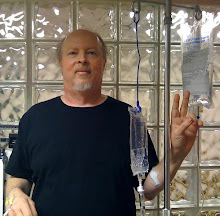When last I wrote, things were looking pretty good. I had gotten a better-than-expected result from bendamustine and rituximab. I was planning on seeing expert Dr. Thomas Kipps at UC San Diego on April 25 to discuss maintenance ideas or what to do at relapse; perhaps one of the BTK inhibitor trials would be a possibility.
And, of course, the day was getting tantalizingly close when I would be able to purchase new and better health insurance from the exchanges that will come online October 1, with the new insurance effective January 1, 2014. The new insurance, I hoped, would cover treatment at a major CLL center or two (such as UC San Diego) and would cover a stem cell transplant, if needed, which my current insurance does not.
I had managed to play for time in somewhat difficult circumstances, and was content. Until one day, around the very end of March or beginning of April, I awoke with a crick in my back.
Sometimes while sleeping I can end up in a contorted position that causes back pain. When this happens, I try to be careful for a few days to lay in such a way as to help my back muscles. Usually the pain diminishes and the problem is solved.
That's what I expected to happen here. The pain persisted, though. I had a routine appointment with Dr. Droll, my Phoenix-area oncologist, on April 5. I recall trying to get comfortable in bed the night before, and making a mental note that the pain was still there. Well, I had moved a couple of heavy boxes, against my better judgment; maybe I had put new strain on the muscles.
The CBC for the appointment showed an unusual result: my platelets had dropped from the 150s to 89. This was not the first time this had happened. Such fluctuations often occurred during my BR chemo. Dr. Droll had been wondering if I had ITP, so this might have fit that pattern. As with so many anomalous blood results on so many tests over the years, it made sense to wait for the next test, to see if this was a one-time blip or the start of a pattern.
There was also a mistake on the bloodwork. I had gone to Sonora Quest with a standing order that included LDH, or lactate dehydrogenase. The evidently dyslexic phlebotomist had input "HDL" into the computer, not LDH. So I was left with a count of cholesterol, not a reading of tissue breakdown, which is a marker of whether a cancer is growing.
Now, for those who don't know, a drop in platelets along with an elevation in LDH can be a sign of Richter's Transformation. I was aware of this, and had been on the lookout for any sign of Richter's since completing BR. Richter's can be a bit hard to disagnose, but other symptoms can include abdominal discomfort, fatigue, and sudden tumor growth.
On all those counts, I felt fine. I could detect no tumor growth. My weight had not changed significantly. I had weighed 185 in December, which is pretty normal for me. I then settled into the low 190s, probably the result of letting myself go, diet-wise. I was not adverse to the occasional dessert involving Scotch and a shortbread cookie.
A repeat CBC on April 15 showed platelets back up to 156, leading me to wonder if the one-time drop had just been an anomaly. The LDH was just mildly elevated at 247 -- two points over the reference range of 112-245. This was a little unusual, but I knew I had some abdominal nodes left over from BR, and I supposed I could be starting to relapse, and I figured I would discuss this with Dr. Kipps.
Meanwhile, the pain in my back had become worse. I could no longer sleep on my right side, just the left. I went to see my primary care doctor, who ordered an X-ray. Sure enough, it showed a compressed disc in the L5, S2 region of the spine. Ugh, I thought, this is a new and unwelcome health thing to deal with. But it did, ostensibly, explain the pain, which was becoming so bad that I needed oxycodone to fall asleep.
Simultaneously, though, I developed rapid weight gain. Between April 12 and 16 I gained 10 pounds. My belly began to look distended. This raised the Richter's warning flag. Every day it seemed to get bigger. On Saturday, April 22 I went to the Sedona ER. An X-ray came back showing what the ER doc took to be a great deal of ascites. This was followed by a CT scan, which confirmed, informally, what we had been suspecting. My abdomen was filled with a huge tumorous mass. The obvious guess was Richter's Transformation.
This was not good news, but I am not one to bemoan my fate. I don't dwell on "why me?" Shit happens, and so does Richter's, to upwards of 10% of CLLers. Nobody knows why, but it does seem to come if you have had the disease for a long time, and it had been almost ten years since my diagnosis. Having abdominal nodes could be a factor, and I have had them for years. It's possible that the Epstein-Barr virus could contribute, and I had mononucleosis as a child, so EBV is still kicking around in my system somewhere. Maybe BR set up the environment for it; if you read the BR studies closely, you will note that there are always reports of Richter's on follow-up.
I figured that if this was Richter's, there would be no better place to be than in Dr. Kipps' office three days later. The pain in my back was now severe and I was unable to sleep laying down. I had to sit up in a chair and rest my head on a pillow on the dining room table. The belly continued to grow. I looked like I was pregnant with twins. For those who are used to the slow pace of CLL, which can come in on little cat feet, this was a shocking experience. Richter's had arrived with all the aplomb of Godzilla tearing through Tokyo.
Preparing for San Diego proved to have its comic moments. The night before we were to leave I suddenly realized that none of my pants would fit. Marilyn had to run to Wal-Mart at 1 a.m. to buy a selection of size 44 and 46 slacks and sweat pants. I managed to find a pair of pants that could be buttoned. Exhausted, we headed off the next day for the eight-hour drive to the sea.
Ironically, we had originally planned to make a mini-vacation of our visit. We had booked a room near the beach in Encinitas, north of San Diego. I could see the waves in the distance through the window. Talk again about the best-laid plans . . . I was in no shape to walk the beach. Everything, even the simplest task, took extraordinary effort to accomplish, and the back pain was ferocious.
My visit with Dr. Kipps is a blur in my memory. He took one look at all bloated 216 pounds of me -- and it was a look of concern -- and suspected what was happening. The exact diagnosis would have to be confirmed by PET/CT scan and lymph node biopsy. It was clear to him that diagnosis and treatment could not wait. Among other things, he was worried that the tumor could be on the verge of causing some kind of kidney damage.
It was established that treatment could not be done at UCSD because of insurance issues; I would return to Arizona the next day, and Dr. Kipps would contact Dr. Droll, which he did both by phone and fax. "Therapy in the next several days appears to be imperative," he concluded in the fax.
The back pain I was experiencing, it turns out, was not the result of a compressed disc. It was the result of a tumor pressing against nerves in my spine, something I never would have guessed when, just a few weeks before, I had awoken with a crick in my back.
This concludes Part 1. So as not to leave you in too much suspense, it did indeed turn out to be Richter's Transformation to aggressive Diffuse Large B Cell Lymphoma. CLL is now the least of my worries. The plan is to achieve the best remission possible, then move on to a stem cell transplant. I have undergone two rounds of treatment (OFAR) with what appears to be a good degree of success. After the first round, my weight dropped to 175. A CT scan before the second treatment showed a massive reduction in node size.
Needless to say, my world has turned upside down. The new normal is considerably more risky and difficult than the old one. Despite all this, there is reason for hope. People do beat Richter's. In Part 2, I will share my treatment experiences, and discuss some of the challenges ahead.
My personal decision to restart my CLL (chronic lymphocytic leukemia)
treatment
-
I have good reasons to believe it is time to re-treat my CLL.
Before deciding on the best therapy choice to treat my CLL/SLL (chronic
lymphocytic leukemia/...
8 months ago





